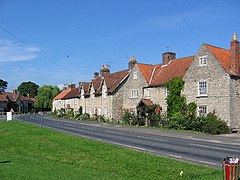Hovingham
| Hovingham | |
|---|---|
 Hovingham |
|
| Hovingham shown within North Yorkshire | |
| Population | 362 (2011) |
| OS grid reference | SE667528 |
| District | |
| Shire county | |
| Region | |
| Country | England |
| Sovereign state | United Kingdom |
| Post town | YORK |
| Postcode district | YO62 4 |
| Police | North Yorkshire |
| Fire | North Yorkshire |
| Ambulance | Yorkshire |
| EU Parliament | Yorkshire and the Humber |
| UK Parliament | |
Hovingham is a large village and civil parish in the Ryedale district of North Yorkshire, England. It is on the edge of the Howardian Hills and about 7 miles south of Kirkbymoorside.
The village is mentioned in the Domesday Book by its current name and lay within the Maneshou hundred. The lands at the time of the Norman invasion belonged to Orm, son of Gamal. After the invasion, the lands were granted to Hugh, son of Baldric. The etymology comes from a combination of houc meaning a place of graves, ing meaning a meadow near a river, and ham meaning a settlement.
There is evidence of Roman activity around the village which sat on the Malton to Aldburgh road in those times. During the construction of Hovingham Hall gardens, a Roman bath, tessalted pavement and other artefacts were uncovered.
The village used to be a stop on the Malton & Thirsk branch of the North Eastern Railway.
The village is within the Thirsk and Malton UK Parliament constituency. It is also part of the Hovingham & Sheriff Hutton electoral division of North Yorkshire County Council and the Hovingham ward of Ryedale District Council. The local Parish Council is a joint one with nearby Scackleton and the council has seven members including the Chair.
An electoral ward in the same name exists. This ward stretches south to Terrington with a total population taken at the 2011 Census of 1,656.
The 1881 UK Census recorded the population as 600. According to the 2001 UK Census, the population was 371, of which 300 were over sixteen years old and 174 of those were in employment. There were 166 dwellings, of which 59 were dsetached. The population at the 2011 Census had marginally reduced to 362.
The nearest settlements are Slingsby 1.75 miles (2.82 km) to the east; Stonegrave 1.6 miles (2.6 km) to the north; Cawton 1.9 miles (3.1 km) to the north-west; Coulton 2.2 miles (3.5 km) to the west south-west and Scackleton 2.1 miles (3.4 km) to the south-west. The village lies at an elevation of 215 feet (66 m) at its highest point and is on the B1257 Malton to Stokesley road. Marr's Beck flows northwards through the village to eventually join the River Rye near Butterwick.
...
Wikipedia

